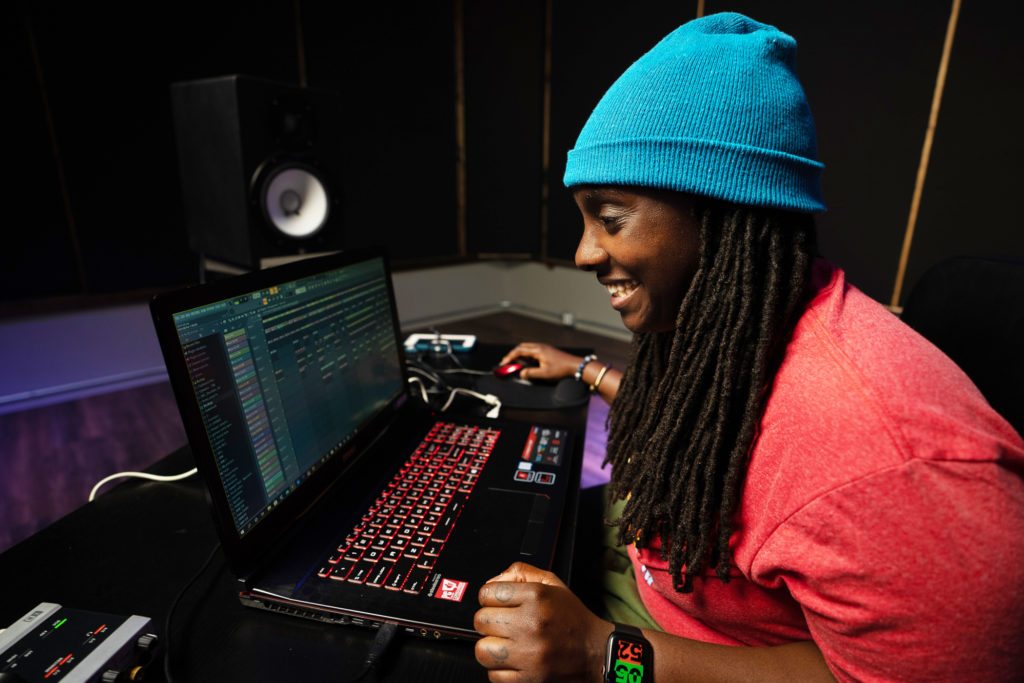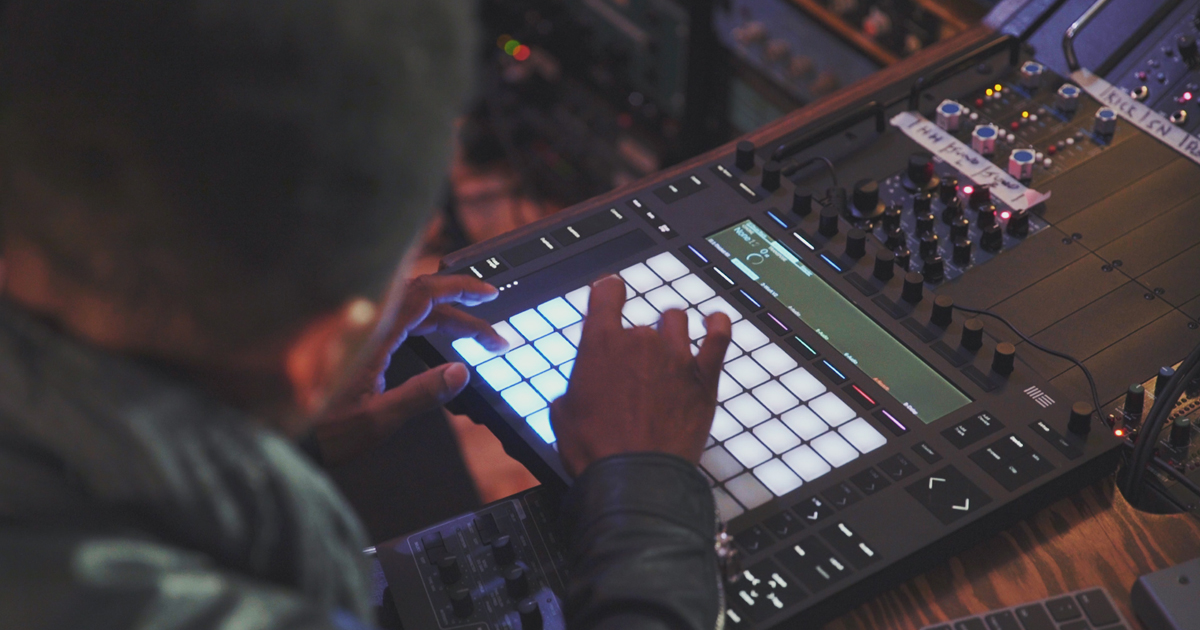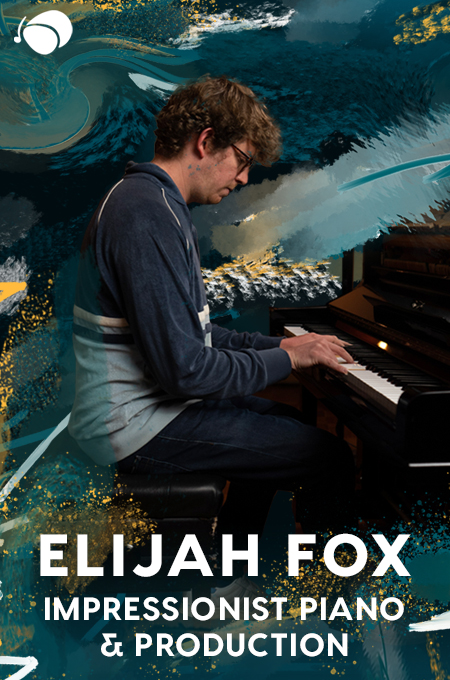+ Learn how to break out of repetitive loops and add emotionality and vulnerability to your tracks with Jlin in Rhythm, Variation, & Vulnerability.
Beat making is truly an art unto itself. And as with any art form, there are certainly tips and tricks that can help you focus your efforts and make your work truly shine. For EDM, hip-hop, and other dance music genres, having a process with steps intended to help you express creativity is a crucial part of your songwriting craft.
But this is not one of those step-by-step guides.
This piece is a reflection on the kinds of gestures and inspirational epiphanies I’ve had while listening to an artist like Jlin, one of today’s most innovative electronic dance music producers. And it’s about how you can insert more creativity into your beat making process just by paying closer attention to a few things along the way.
And, because Soundfly just launched our brand new online course with Jlin herself, there’s no better place to turn than right back to her music, to explore these concepts in action. Take a listen:
Capturing Bursts of Inspiration
The first piece of advice to glean from an artist like Jlin is that it’s worth it to capture your ideas as soon as they appear to you — no matter how simple or disconnected they are.
Jlin has been quoted as saying that most of the time, her final track is completely unrecognizable from the first draft. But having some kind of starting point to work from is a crucial step in your creative process. So make it a habit to record your ideas as soon as they strike you.
Whether you track them in the studio, record yourself vocally mimicking your idea as a scratch track, or simply make notes to yourself in your iPhone; capture that creative gem the instant it appears and don’t let it slip away.
+ Read more on Flypaper: “Resistance Is Futile: On Letting Creative Flow Just Happen.”
Building Out a “Rough Finished” Track
As you begin working to build a full beat or track out of an initial spark of an idea, you may not know where to go and so it may not all come together into an instant hit. Don’t let this discourage you. Build the best thing you can for your first full “rough draft,” and don’t let its lack of perfection paralyze you.
It’s quite common to not know how to add details until you’ve seen the whole picture. Every time I listen to a song like Jlin’s “Erotic Heat,” I’m struck by all the micro-variations that occur bar after bar, which subtly change the texture and feel of the track, even though dynamically it barely deviates from the energy it starts with.
It’s clear this, and many of her songs, are works that involved going back through a hundred times to find little moments to embellish specifically. That’s okay — this process takes time!
You may not know the best way to start your beat until after you’ve finished it. The inspiration for a midpoint instrumental breakdown could suddenly come to you after you’ve heard your first draft in its entirety. Allow yourself to keep working at it until you have something finished, even if it’s not the final product you envisioned.
The main goal is to not let the kernel of your original idea go to waste. Trust that creative ideas will come to you as you continue to trudge down the path towards the finish line.
+ Learn production, composition, songwriting, theory, arranging, mixing, and more; whenever you want and wherever you are. Subscribe for full access!
Finding One’s Own Sound
Most people find that they naturally adhere to at least some basic principles of “sound-crafting” that meet the expectations of their intended audience. This is perfectly acceptable, and probably a good idea so that you have your listeners foremost in your mind when developing a beat. But, at some point you should review your work and make sure you’re not just mechanically cranking out emotionless cliché material.
Listen through your work for any particular aspects (present, or notably missing) that especially speak to you personally.
Jlin often talks about how when she first started creating music, her mother asked her “what do you sound like?” It was this critical question that helped set her on the path toward developing a distinct musical flavor that truly represents who she is in her music.
You should ask yourself this same question when reviewing your material.
- Is that oddly filtered sound you dropped in seemingly randomly at one point something that feels like “you?” If so, perhaps find ways to utilize that type of element more often, or perhaps redesign the track around that one sound as the highlight of the song.
- Did you add a bunch of standard repeating beats because everyone else does it that way, even though you don’t care for it yourself? If so, perhaps you should remove them or find a way to alter them in a way that’s unique.
It’s possible small alterations like those could become your signature in all of your beats — the thing that your listeners recognize as quintessentially “you.”
“What do you sound like?”
Comparing Your Work
Now that you’ve captured inspiration, turned it into a first draft, then refined it by developing your own sound throughout the song, it’s time to compare it to other songs to see how it holds up. Of course there are literally millions of songs you could compare with, but you can probably think of a handful of artists that inspire you — whose songs you see as being a standard of achievement that you would like to reach.
Can you hear the basis for their creative inspiration in their song? How did they arrange the track to create a finished piece around certain central concepts? What elements within it define it as their own unique sound?
Listening to Jlin’s “Black Diamond,” I initially noticed the use of human voice samples throughout that feel like they are literally speaking to me through the music; perhaps one or more of these voice samples was the starting spark of inspiration for the whole track.
In this same track, you can hear a song development that starts minimally and builds gradually to a heavy, engaging rhythmic beat. The original arrangement may not have started this way, but the final version that was released has a natural dynamic build-up that is captivating and likely came out of multiple efforts at adding and subtracting elements from the mix.
Finally, Jlin’s brilliant aptitude with creatively filtering and effecting sound samples in her songs is obvious right from the start. This is an aspect of many of her tracks and helps the listener know without a doubt that this is definitely a “Jlin beat.”
Listen actively to your favorite artists, or those whose work is relevant to the track you’re making. Can you identify the elements about their work that you’d like to emulate in your work? (I’m not talking about copying anything.) What refinements could you make to help the creativity in your original inspiration, your development of the full track, and in your expression of your own sound, shine through even better?
Taking Your Track for a Test Drive
We all know a song intended to be heard by others must eventually be shared with others. Once you’ve reached this stage of your creative process, it’s time to let that to happen. I know it’s hard, don’t be shy. You’ve put a lot of time and effort into getting your song to this point.
Let a select group of people hear it, even if you don’t think it’s their style or perhaps they may not get what you’re going for. This “test drive” of your song is your final opportunity to look for creative additions and adjustments before it’s forever released to the whole world.
You may be surprised at the interesting ideas you get from friends, family, fans, and collaborators regarding what they like in the song now and what they’d like to hear more of or less of. You might be surprised at the positive ideas you can derive from people who don’t care for your music or don’t like this particular song. If you’re open to their input and listen with a creative mindset, you may discover possibilities for alterations to your current song — or even ideas for your next song — from even the most unlikely of sources.
Some of the greatest moments of creative inspiration often hit us when we least expect it.
Ready for even more?
Check out Soundfly’s variety of courses on songwriting, mixing, beat making, recording, composing, and more, led by artists like Kimbra, Com Truise, Jlin, Kiefer, The Pocket Queen, and RJD2: From Samples to Songs.





